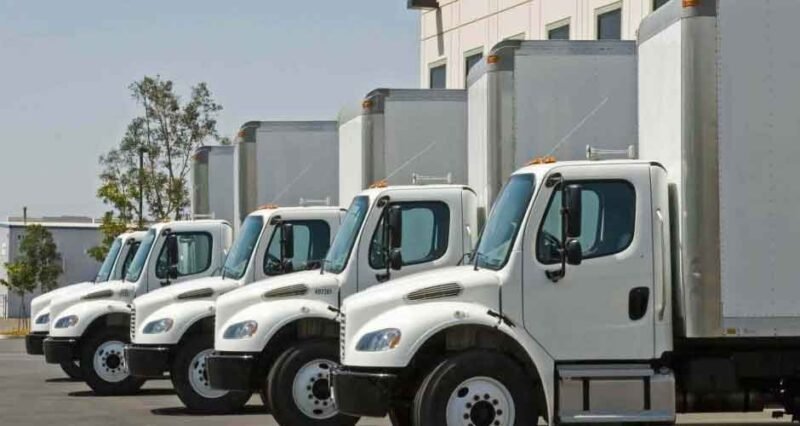
If you’re a fleet owner, then you know how important it is to keep your trucks in good condition. After all, maintenance is one of the best ways to ensure that your fleet operates as efficiently as possible and keeps your drivers safe. We’ve assembled a list of Medium duty truck parts that should be replaced at least once per year (if not more often). Each section below will tell you what parts need replacing when they run out of life, how often they should be replaced, and why it’s important to replace them when they do start showing signs of wear.
Air Compressor
The air compressor is an important part of your truck. It powers the air brakes, which allow you to keep control during braking and to avoid skidding. The engine turns a pulley attached to a pump that compresses air into a reservoir, where it can be stored until needed by the brakes.
The compressor also helps with weight distribution, as it is mounted low on the vehicle (between the front axle and cab). The additional weight in this area helps prevent overloading and keeps balance when hauling heavy loads or driving on uneven terrain.
Because this system is so critical for safety and performance, you should have regular maintenance done at least once every year or 100 hours of use–whichever comes first! If something goes wrong after that point (or sooner), don’t hesitate–call us right away so we can get started fixing whatever needs fixing ASAP!
Alternator
An alternator is a device that converts mechanical energy into electrical energy. It’s powered by the engine, and it keeps your truck running smoothly. When you turn on the lights or stereo, or start up your engine, you’re using electricity from the alternator.
If this piece of equipment fails, it can cause all kinds of problems: dead batteries; dim headlights; an inability to start up your vehicle; even overheating and fire risk due to insufficient power supply for critical components such as air conditioning systems and anti-lock brakes (ABS).
To check whether your alternator needs replacing or repair work done on it:
Break System
When it comes to your medium-duty truck, the break system is the most important part of the vehicle. Break systems provide stopping power for your truck, which is vital for safety purposes. Whether you’re driving down a steep hill or through traffic, having working breaks will ensure that you can keep control of your vehicle and avoid accidents.
To keep your break system in good shape, make sure that regular inspections are performed by qualified technicians who know what they’re doing. If there are any issues with how well or how often they work (or even if there aren’t any issues), these technicians will be able to fix them before they become serious problems later on down the road!
Cooling System
The cooling system is a series of pipes and hoses that carry coolant through the engine.
Coolant is circulated through the engine by the water pump, which draws it from your vehicle’s radiator and sends it back into that same radiator to be cooled again. The heater core warms up this same coolant so that it can be used for defrosting windows, etc., when needed.
Differential
The differential is the part of your vehicle that allows you to turn. The axle connects to both wheels on each side of the vehicle, but it’s connected at different angles. In a car, one wheel will turn faster than the other; in a truck, both axles have their own wheels and they only turn at different speeds when you need them to–for example, when turning or driving up an incline.
The differential is also responsible for distributing power from your engine into each wheel as needed based on how much traction each tire has with respect to ground contact area (the larger this gets, the more traction). If you’ve ever heard someone say “put some more weight in back” before pulling out onto snowy roads or ice-covered roads after snowfall (or even just normal rain), they were referring directly toward maximizing positive torque transfer through good weight distribution within your vehicle’s chassis system via differential action between front/rear axles’ rotational speed ratios (differential gearing).
Electrical System
An electrical system is an essential part of your truck. It powers everything from the lights to the air conditioning, so it’s important that you keep it in good shape.
Electrical parts include:
Battery
Alternator (generator)
Starter motor/starter solenoid/starter relay
Engine/Transmission Assembly
The engine and transmission are the heart of your truck, and they’re made up of many parts. If one of these systems breaks down, you can replace it with a new engine or transmission assembly; repair the existing piece; or rebuild it to like-new condition.
If you need to replace your vehicle’s engine/transmission assembly with a new part, make sure that you get one that matches the original specs closely enough so that there won’t be any problems integrating with other components in the system (like connecting rods).
If you have an older truck whose engine/transmission assemblies are starting to wear out but don’t want to spend thousands on a brand new model just yet–or if something else happens during normal operation such as overheating due to lack of maintenance–then consider getting repairs done instead of buying all new parts right away! We offer complete service packages as well as individual services such as tune-ups if needed too!
Fuel System/Fuel Pump Module/Fuel Tank
Fuel tank: The fuel tank is the container that holds your truck’s gasoline. It’s usually made of steel or aluminum and can be either integral or removable, depending on the vehicle you’re working with.
Fuel pump module: This device sends pressurized gas from the tank to other parts of your engine via tubes, hoses and valves. The most common type of fuel pump module is an electric one–it contains an electric motor with a gearbox that operates at high speeds as well as various valves to control flow rates, pressures etcetera depending on what kind of vehicle you have (i e diesel vs gas).
Fuel filter: Filters remove contaminants from both liquid fuels like diesel or gasoline as well as gaseous ones like natural gas or propane by trapping them within their porous walls before letting them pass through into other components such as tanks where they can be stored safely until needed later down line after being tested first by testers who check whether there are any cracks in these filters’ construction before recommending replacements for damaged ones so customers don’t have any problems using them later down road once again which could lead towards serious accidents occurring due incorrectly maintained equipment being used improperly due lack knowledge regarding how best practices should be followed when doing tasks involving maintenance procedures related specifically towards these types equipment sets up appropriately beforehand.”
Hydraulic System (6-Wheel) – Aluminum Frame Trucks Only
The hydraulic system is used to power the brakes, steering and suspension. It’s a closed-loop system that uses pressurized fluid to provide power to the various components of your truck. The air compressor supplies this pressure, which is controlled by the brake pedal.
When you press down on the brake pedal in your 6-wheel aluminum frame truck, you’re activating an electric switch that tells an electronic control module (ECM) to engage the pump motor at its highest speed setting–this creates enough force to compress air into its reservoir tank so it can be released into all four wheels’ reservoirs at once via individual valves on each side of each wheel well (for front/rear axle/steering brakes).
The ECM then directs this pressurized air through tubes connecting each wheel’s reservoir with its respective caliper assembly; here they meet up with two pistons inside each caliper: one pushing outwards against brake pads while another pulls inward against them from inside its housing.”
Suspension and Steering Assembly – Aluminum Frame Trucks Only
The suspension and steering assembly of a medium duty truck is an integral part of the vehicle’s ability to smoothly operate on the road. It helps to keep your tires in contact with the ground, which allows you to maintain traction and control while driving.
The main parts of this system are:
Steering knuckle – connects wheels to axle shafts or hubs
Shock absorbers (also called shock absorber assemblies) – dampens vibrations from bumps in road surfaces or uneven terrain by absorbing energy through hydraulic fluid pressure changes inside them; also keeps tires from bouncing when going over bumps
Springs – provides a restoring force for unsprung weight such as passengers and cargo loads by rebounding after being compressed under load
Keeping your fleet running smoothly takes a lot of work, but it’s worth it.
Keeping your fleet running smoothly takes a lot of work, but it’s worth it. The most important thing is to keep up with regular maintenance and repairs. Here are some things that can happen if you don’t:
Your trucks will break down more often, which means lost revenue for you and more stress for everyone else in the company.
It costs more money to fix broken parts than it does to replace them before they break (and sometimes even after).
Poorly maintained trucks also have higher fuel consumption rates because they’re not running at peak efficiency–this can result in increased carbon emissions as well as reduced fuel economy.
Conclusion
We hope this article has given you a better idea of how to keep your fleet running smoothly. If you have any questions, please don’t hesitate to contact us at any time! We love hearing from our customers and look forward to helping you with all your needs.

